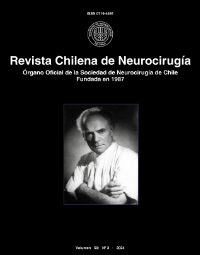Superior semicircular canal dehiscence. Literature review regarding a case of neurosurgical management
##plugins.themes.bootstrap3.article.main##
Abstract
Superior semicircular canal dehiscence syndrome (SDCSS) is a little-known pathology that has recently been described. It is characterized by vestibular and/or auditory symptoms induced by loud noises or pressure changes, which affects the quality of life of those who suffer from it. This syndrome could be explained by a mobile “third window” phenomenon between the superior semicircular canal devoid of its bone cover (due to congenital and/or secondary causes) and the adjacent dura mater, allowing a new decompression pathway to acoustic stimuli, which are partially dissipated to the cochlea and vestibular labyrinth, generating the symptoms of the disease. The diagnosis is clinical, with directed anamnesis being essential, supported by cochleovestibular functional examinations suggestive of the biomechanical effect of dehiscence, and corroborated with imaging studies (CT of the ear, MRI of the brain). When a diagnosis of SDCSS is confirmed, it is important to inform the patient about the situation and possible treatments: conservative, consisting of general measures that avoid the stimuli that trigger the symptoms, and surgical, when the symptoms are disabling. The most frequent approaches are through middle
##plugins.themes.bootstrap3.article.details##
superior semicircular canal dehiscence syndrome, third window phenomenon, middle fossa craniotomy, transmastoid approach
Minor LB, Solomon D, Zinreich JS, Zee DS. Sound-and/or pressure-induced vertigo due to bone dehiscence of the supe- rior semicircular canal. Arch Otolaryngol Head Neck Surg 1998; 124:249-58. DOI: https://doi.org/10.1001/archotol.124.3.249
Eberhard KE, Chari DA, Nakajima HH, Klokker M, Cayé-Tho- masen P, Lee DJ. Current Trends, Controversies, and Future Directions in the Evaluation and Management of Superior Canal Dehiscence Syndrome. Front Neurol. 2021;12: 638574. DOI: https://doi.org/10.3389/fneur.2021.638574
Dlugaiczyk J, Burgess AM, Goonetilleke SC, Sokolic L, Curthoys IS. Superior Canal Dehiscence Syndrome: Relating Clinical Findings With Vestibular Neural Responses From a Guinea Pig Model. Otol Neurotol. 2019;40(4): e406-e414. DOI: https://doi.org/10.1097/MAO.0000000000001940
Steenerson KK, Crane BT, Minor LB. Superior Semicircular Ca- nal Dehiscence Syndrome. Semin Neurol. 2020; 40(1): 151-159. DOI: https://doi.org/10.1055/s-0039-3402738
Jacky Chen CH, Nguyen T, Udawatta M, Duong C, Romiyo P, Sheppard JP, et al. Clinical Assessment of Patients with Bilate- ral Superior Semicircular Canal Dehiscence. World Neurosurg. 2019; 126: e1549-1552. DOI: https://doi.org/10.1016/j.wneu.2019.03.205
Ward BK, Van De Berg R, Van Rompaey V, Bisdorff A, Hullar TE, Welgampola MS, et al. Superior semicircular canal dehis- cence syndrome: Diagnostic criteria consensus document of the committee for the classification of vestibular disorders of the Bárány Society. J Vestib Res. 2021;31(3):131-41. DOI: https://doi.org/10.3233/VES-200004
Bi WL, Brewster R, Poe D, Vernick D, Lee DJ, Corrales CE, et al. Superior semicircular canal dehiscence syndrome. J Neurosurg. 2017; 127(6): 1268-1276. DOI: https://doi.org/10.3171/2016.9.JNS16503
Ahmed W, Rajagopal R, Lloyd G. Systematic review of round window operations for the treatment of superior semicircular canal dehiscence. J Int Adv Otol. 2019; 15(2): 209-214. DOI: https://doi.org/10.5152/iao.2019.6550
Bhatt AA, Lundy LB, Middlebrooks EH, Vibhute P, Gupta V, Rhyner PA. Superior Semicircular Canal Dehiscence: Covering Defects in Understanding from Clinical to Radiologic Evaluation. Clin Neuroradiol. 2021; 31(4): 933-941. DOI: https://doi.org/10.1007/s00062-021-01037-x
Walsh EMC. Current management of superior semicircular canal dehiscence syndrome. Curr Opin Otolaryngol Head Neck Surg. 2020; 28(5): 340-345. DOI: https://doi.org/10.1097/MOO.0000000000000657
Wung V, Romiyo P, Ng E, Duong C, Nguyen T, Seo D, et al. Sealing of superior semicircular canal dehiscence is associated with improved balance outcomes postoperatively versus plu- gging of the canal in middle fossa craniotomy repairs: a case series. J Neurosurg. 2019; 1-5. DOI: https://doi.org/10.3171/2019.4.JNS19264

This work is licensed under a Creative Commons Attribution-NonCommercial 4.0 International License.








